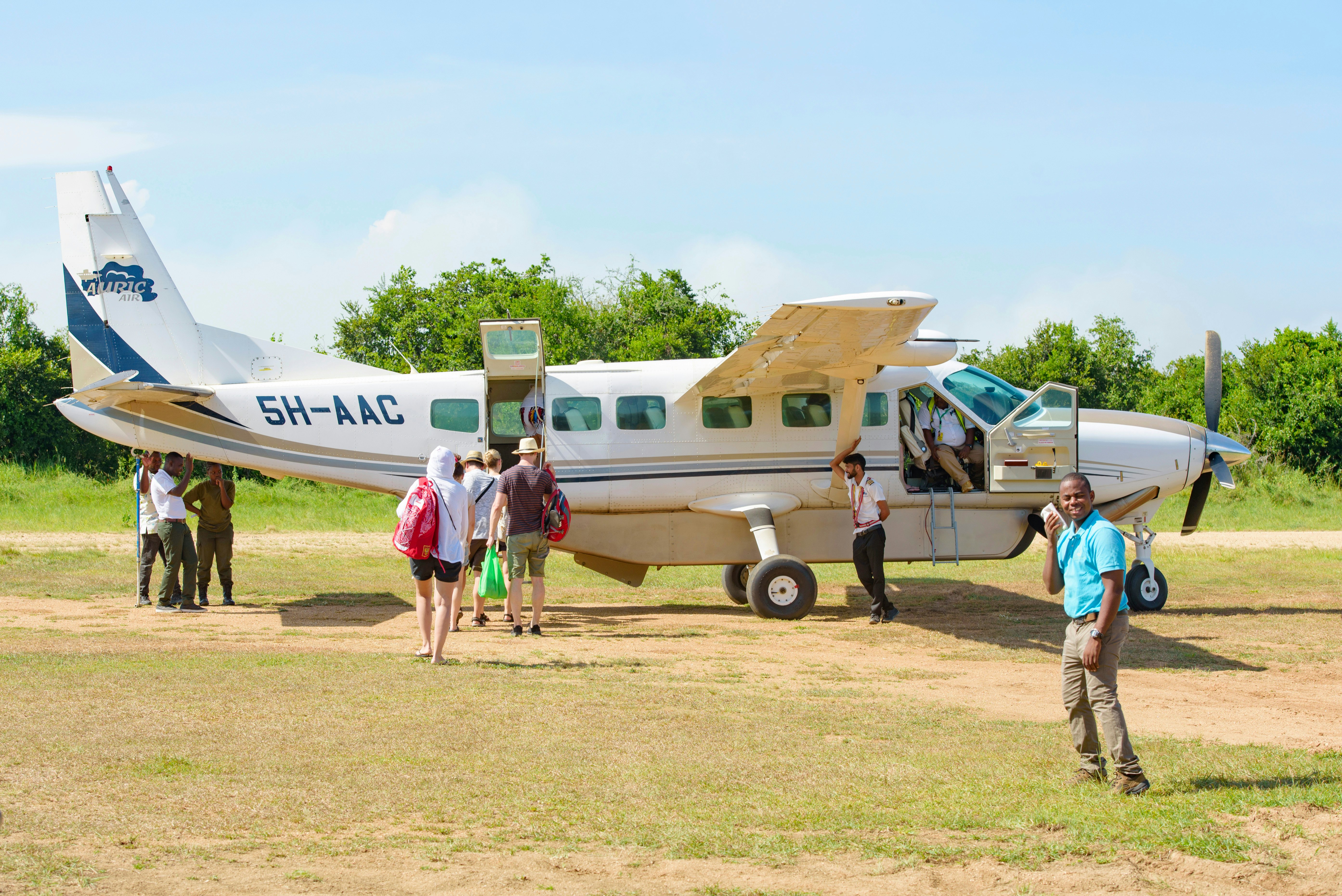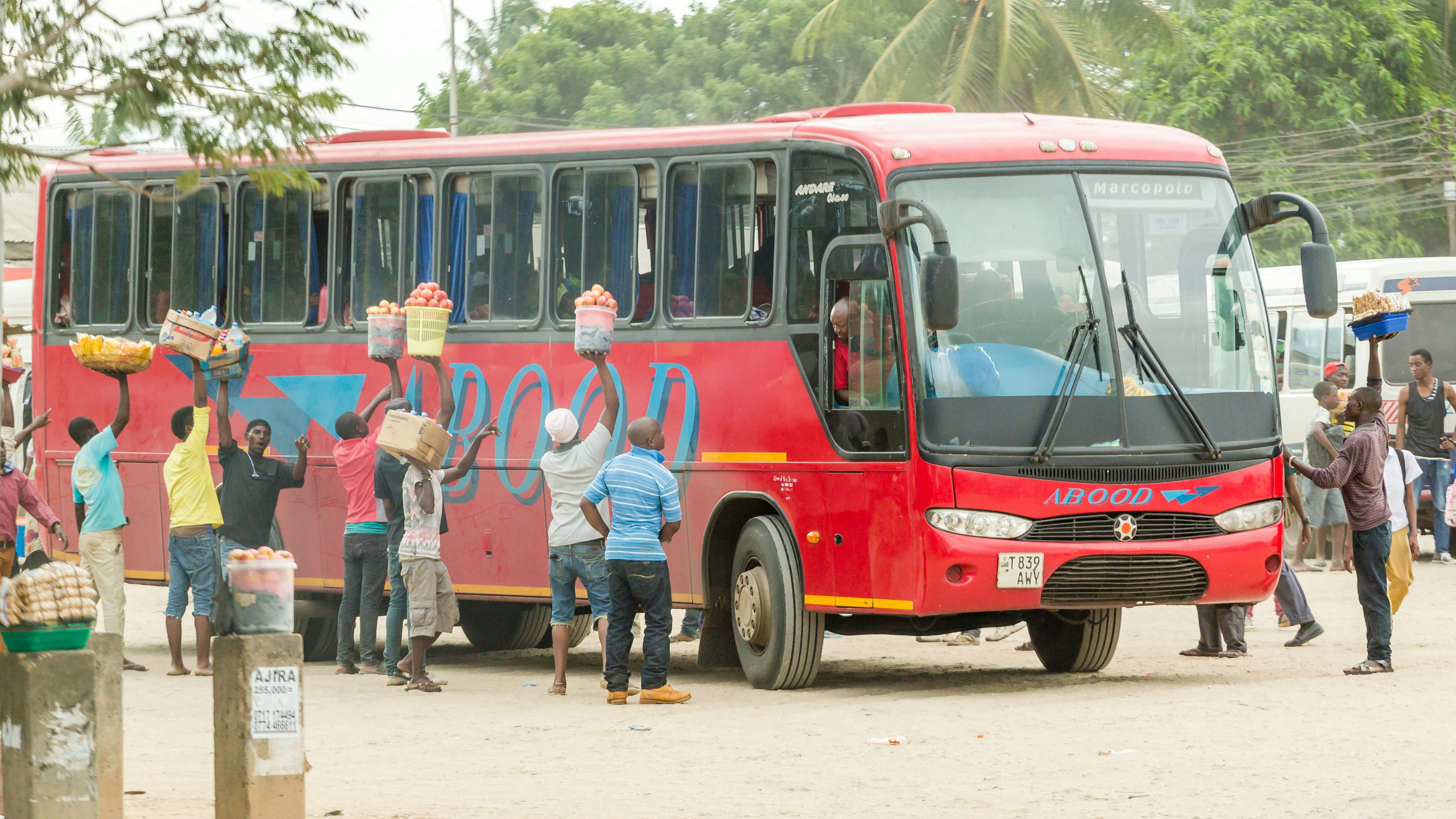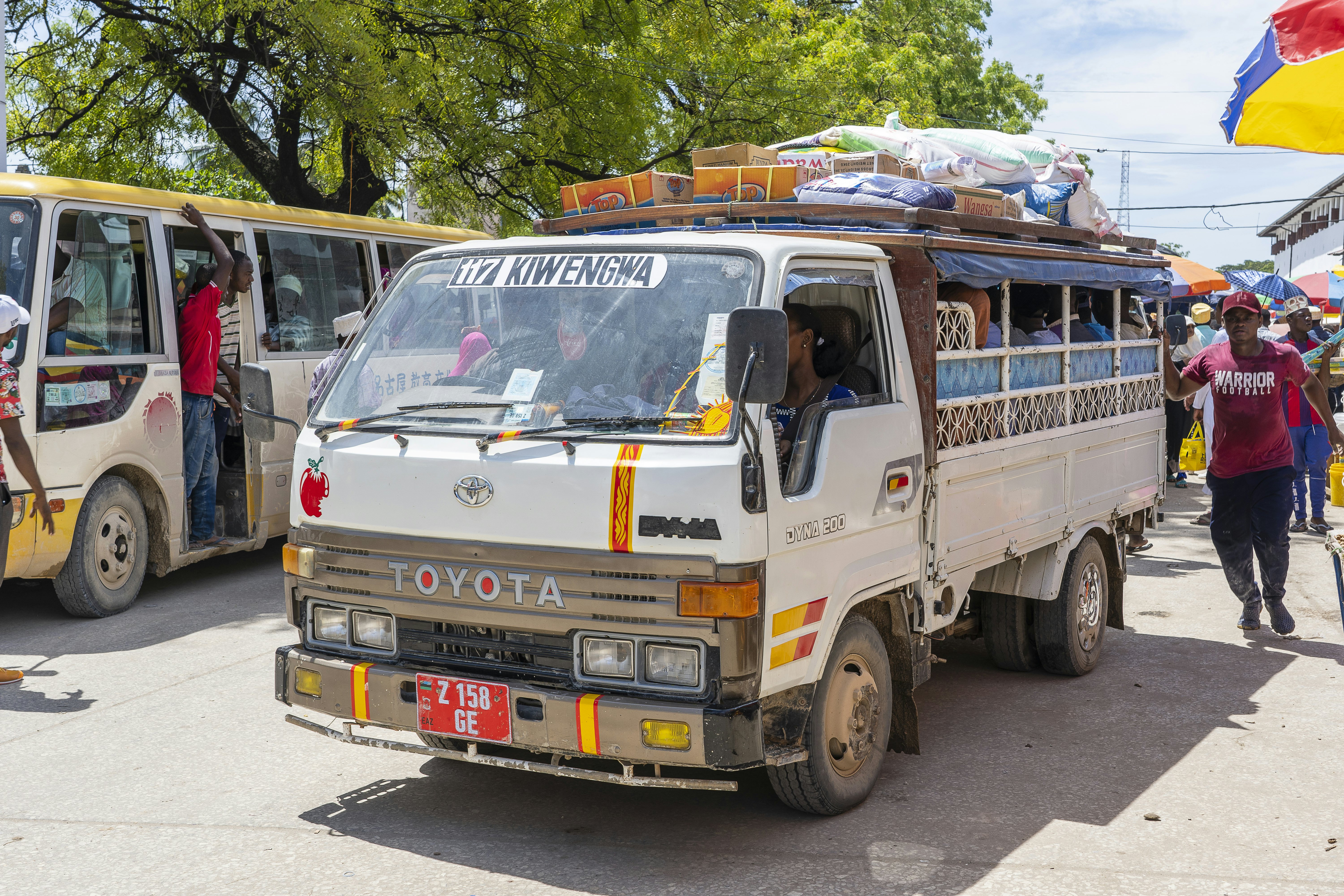

Abundant public transport makes it easy to explore the diverse landscapes and cultures of Tanzania © Mitch Diamond / Getty Images
The majority of travelers visiting Tanzania are here to enjoy the wilderness of the African bush, so the roads connecting destinations on the popular Northern Circuit – linking the Serengeti, Ngorongoro Crater, Kilimanjaro National Park, and a string of other sights and wildlife reserves – are well-maintained.
Away from these touristed areas, however, overland travel can be slow and uncomfortable. Many prefer to cover long distances by plane, particularly when accessing remote lodges and tented camps in Tanzania's national parks, though this can be expensive.
For those who cannot afford the lavish prices of air transfers, buses are a terrific option. Within cities and towns, dalla dalla (community minibuses), boda boda (motorcycle taxis), and bajaji (tuk-tuks) are all cheaper than conventional taxis. Then there are trains on Tanzania's modest rail network, boats linking the islands in the Indian Ocean, and towns along Lake Victoria and Lake Tanganyika.
Many adventurous travelers choose to self-drive with a rented 4WD vehicle, though driving conditions and crime are challenges. Away from major centers, roads are rarely tarred and can be a nightmare to drive on – don't be too ambitious about how much ground you can cover in a day. Here's a guide to the best ways to get around in Tanzania.

Flying is the fastest way to get around Tanzania
Tanzania has three international airports served by a wide range of international and regional airlines (with particularly good connections to other parts of Africa and the Gulf). In Dar es Salaam, Julius Nyerere International Airport is the busiest international hub, with connecting flights to regional airports and private airstrips all over Tanzania.
Known as the “Gateway to Africa’s Wildlife Heritage,” Kilimanjaro International Airport (between Arusha and Moshi in Hai District), is served by flights from a handful of countries in Europe and the Middle East, plus local hops and charter flights to and from northern Tanzania's national parks.
Over in Zanzibar, Abeid Amani Karume International Airport brings in travelers looking for white sand, blue skies, and warm ocean waters, with lots of connections to African capitals and the Middle East, and seasonal flights from Europe.
Domestic Tanzanian airlines such as Air Tanzania and Coastal Aviation operate daily flights from major cities to popular tourist centers such as Arusha, Zanzibar, Mafia Island, Mwanza, Pemba Island, and Iringa. Some smaller towns and islands receive less frequent scheduled flights using small aircraft with small baggage allowances.
Tip for flying in Tanzania: Many high-end safari lodges have their own airstrips and use private charter companies to shuttle guests in, avoiding long days of travel by road. Fares are typically included in the final rate you pay, but many charter airlines have a 15kg per passenger baggage allowance and ask passengers to use soft-sided bags rather than hard suitcases.

Rent a 4WD to explore Tanzania independently
Tanzania has an extensive road network covering almost 90,000km (56,000 miles), but only 15% of the country's roads are tarred. If you’re not deterred by the local driving conditions, then going on a road trip on your own or with friends can be a very enjoyable way to explore.
Because road conditions deteriorate quickly once you leave the main towns, hiring a Land Cruiser or a similar 4WD with an accompanying driver is a good idea. Your driver will act as an unofficial tour guide and will be much more comfortable navigating Tanzania's potholed roads.
Car rental agencies located in major towns and cities such as Dar es Salaam and Arusha charge from US$50 per day for a basic 2WD car and upwards of US$150 a day for a 4WD. Insurance is extra, and you'll pay another US$30 to US$50 per day for a driver. Most hire companies also offer roadside assistance in the event of mechanical problems.
You'll need to present your driver’s license at their offices. Agencies will usually accept a license from your home country so long as it’s in English; otherwise, bring an International Driving Permit. You can hire a 4WD equipped with camping gear for national park trips, but avoid driving at night because of potholes and wandering wildlife. Even by day, wild and domestic animals and children running into the road can be a constant challenge.
Tip for renting a car in Tanzania: When parking in towns, car guards or attendants will look after your car for a small fee, providing a ticket to be displayed on your windscreen. Never leave anything of value in your vehicle, and keep your doors locked while driving in town to reduce the risk of crime.
Taxis and ride-shares are useful for city hops and airport transfers
At most airports, bus stations, train stations, and shopping centers within city limits, you’ll be able to find a taxi relatively easily. Tanzanian taxis are white, or have white license plates, and can be hailed from the roadside, but it's easiest to ask your hotel or restaurant concierge to organize one for you.
Alternatively, Uber has made a lucrative niche for itself in Tanzania, so ride-shares are another easy option. Many hotels and lodges have in-house shuttles to ferry you from or to the airport and other transport hubs.
Tips for taking taxis in Tanzania: Tanzanian taxis are not metered, so you should always negotiate a price before you get into one. At the airports in Dar es Salaam and Zanzibar, taxi associations post lists of fares to key destinations as a guide.

Buses are an inexpensive way to travel in Tanzania
For the budget-conscious, Tanzania has an expansive bus network covering almost everywhere you can reach by road. The John Magufuli Bus Terminal in Dar es Salaam sees about 3000 buses pass through each day to all corners of the country. Buses can be quite fast on major intercity roads but can be slow on minor tracks, and frequent stops are the norm.
Various bus companies travel from Dar es Salaam to the coast and towns across Tanzania, and to border crossings to neighboring countries, with some international services to Kenya, Rwanda, and Uganda. Buses range from rattletraps to luxury buses with aircon and toilets, and all make regular rest stops for food and toilet breaks. Kilimanjaro Express, Shabiby Line, Dar Express, and Ratco Express are the most reliable and comfortable companies.

Local buses are handy for exploring big cities
To ease traffic congestion in Dar es Salaam, the Tanzanian government introduced the Bus Rapid Transit (BRT) system, helping millions of residents avoid the city's notorious traffic jams. Buses operate in designated lanes, allowing for easy movement – it's estimated that the BRT system is giving six days of travel time per year back to residents.
Only parts of Dar es Salaam are covered by these blue buses, but they're great for exploring the city center. Simply look out for the ticket offices, built on stilted corridors on the roadway. The destination of each bus is illuminated on the front of the bus and there's also a route map at every station.
Tip for getting around by bus in Dar es Salaam: The third floor of the John Magufuli Bus Terminal is where you go to buy tickets. There are many companies here so compare prices and schedules before you book. Be wary of touts approaching you and offering their services to help with booking. Go to the ticket office yourself to be sure you are paying the right fare. The second floor has a waiting area, and also an indoor market where you can buy food and souvenirs and charge your phone.

Trains are an atmospheric and cheap way to explore Tanzania
Traveling by train around Tanzania is another cheap option, although services can be unreliable. The Tanzania Railways Corporation (TRC) runs a deluxe passenger service from Dar es Salaam to Kigoma on Lake Tanganyika in Western Tanzania and a limited commuter train service in Dar es Salaam.
TRC also offers a few passenger services a week from Dar es Salaam to Arusha via Moshi, to Mwanza via Tabora, and services between Tabora and Mpanda. See their website for schedules. It's worth paying the higher fares for 1st and 2nd-class coaches with onboard catering and wi-fi, rather than squeezing into seating-only 3rd-class carriages.
Tanzania-Zambia Railway Authority (TAZARA) runs express services and ordinary passenger services from Dar es Salaam to New Kapiri Mposhi in Zambia via Mbeya and Tunduma. Again, there are 1st, 2nd and 3rd-class tickets. To avoid an uncomfortable journey, book seats in higher classes at least a day or two before your intended journey.

Ferries and water taxis link coastal islands and lakeside towns
Ferries and water taxis ferry passengers from the mainland to the islands of Unguja (Zanzibar and Pemba) and between the various islands in the Zanzibar archipelago. Azam Marine is one of several companies carrying passengers between Dar es Salaam and Zanzibar. Ferry tickets must usually be paid for in US dollars. Local cruises by chartered dhow are also popular.
Several ferry services connect towns along the shores of Lake Victoria and Lake Tanganyika (and sometimes on Lake Nyasa), but routes are subject to regular changes. On any ferry route in Tanzania, stick to daytime travel and avoid traveling in bad weather.

Local transport is cheap but crowded
The dalla dalla – a shared minibus that operates a bit like a local bus service – is ubiquitous in Tanzania. These zippy little minibuses are a great way to travel around the country and experience Tanzanian culture, but they're often overcrowded. Avoid the front seats next to the driver, as collisions are common. Although many dalla dalla run on fixed routes, they tend to stop anywhere for drop-offs and pickups.
If you need to get somewhere quickly, consider taking a boda boda (motorcycle taxi). It’s an inexpensive and fast way to get around, but also quite dangerous. Drivers rarely carry extra helmets for passengers, and it's not unknown for a driver to carry two pillion passengers at the same time.
For a safer local trip, the bajaji is an extremely useful mode of transport in Tanzania. Imported from India, these tuk-tuks are covered motorcycles running on three wheels. They're common in cities, but you may not find them in more rural areas. They also tend to be very dusty as the cab is partly open.
Tips for local transport in Tanzania: Carry as much small change as you can when taking local transport so you can pay the exact fare. Drivers won't always have change, particularly for large bills. Speak to local people to get a feel for the fares that are usually paid, and negotiate with the driver before boarding to agree on a fare.
Accessible transportation in Tanzania
While there are few dedicated facilities for travelers with disabilities, Tanzanians are accommodating and happy to offer assistance where they can. Sidewalks are rarely suitable for wheelchairs but tour agencies in Dar es Salaam and Arusha can arrange safaris for people with mobility issues. Note that hotels rarely have lifts, and many have entrance steps – game lodges are often built at ground level, but paths can be rocky and uneven. Contact lodges ahead of time if you have special requirements.
For more information, see Lonely Planet's Accessible Travel Resources.
















